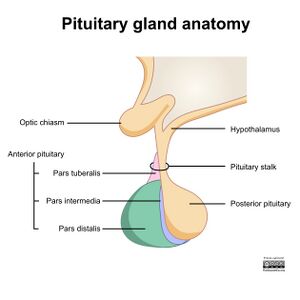Pituitary Gland: Difference between revisions
No edit summary |
No edit summary |
||
| Line 19: | Line 19: | ||
# Prolactin | # Prolactin | ||
Posterior pituitary: neural in origin. Unlike the anterior pituitary, the posterior pituitary is connected directly to the hypothalamus via a nerve tract (hypothalamohypophyseal nerve tract). Oxytocin and antidiuretic hormones are synthesised in the hypothalamus and travel down the nerve tract to be released in the posterior pituitary.<ref>El Sayed SA, Fahmy MW, Schwartz J. [https://www.statpearls.com/articlelibrary/viewarticle/767/ Physiology, pituitary gland.]Available:https://www.statpearls.com/articlelibrary/viewarticle/767/ (accessed 14.1.2023)</ref> | Posterior pituitary: neural in origin. Unlike the anterior pituitary, the posterior pituitary is connected directly to the hypothalamus via a nerve tract (hypothalamohypophyseal nerve tract). Oxytocin and antidiuretic hormones are synthesised in the hypothalamus and travel down the nerve tract to be released in the posterior pituitary.<ref name=":0">El Sayed SA, Fahmy MW, Schwartz J. [https://www.statpearls.com/articlelibrary/viewarticle/767/ Physiology, pituitary gland.]Available:https://www.statpearls.com/articlelibrary/viewarticle/767/ (accessed 14.1.2023)</ref> | ||
== | == Pathology == | ||
This gland often develops pathology, which may have an effect adjacent intracranial structures or be hormonally active. Pituitary adenomas are present in 14% of autopsy studies and 23% of radiology studies.<ref name=":0" /> | |||
The more common pituitary conditions include: | |||
* Hyperprolactinaemia (too much prolactin in the blood). | |||
* [[Growth Hormone|Growth hormone]] deficiency: can delay children’s growth and lead to a child being shorter in height than expected. In adults, the symptoms of growth hormone deficiency include fatigue, weak muscles and bones, excess weight, anxiety, mood problems or sleep problems. | |||
* Hypopituitarism: a deficiency of all the pituitary hormones and causes many different symptoms. | |||
Uncommon pituitary conditions include: | |||
* Gigantism — where a person grows very tall | |||
* [[Acromegaly]] — where a person’s hands, feet and jaw enlarge | |||
* [[Cushing's Syndrome|Cushing’s syndrome]] — where the body creates too many steroid hormones | |||
== Sub Heading 3 == | == Sub Heading 3 == | ||
Revision as of 08:14, 14 January 2023
Original Editor - Lucinda hampton
Top Contributors - Lucinda hampton
Introduction[edit | edit source]
The pituitary gland is a tiny but vital organ and is seen as the master gland, acting as the main endocrine interface between the central nervous system and the entire body. It is found at the base of the brain, below the hypothalamus, in a bony hollow, just behind the bridge of your nose . It is about the size of a pea.[1][2] The hypothalamus controls the pituitary by sending it messages.[3]
Anterior and Posterior Pituitary
Anterior pituitary: the largest part of the gland, secreting six hormones, each with a specific functions and target organs:
- Growth hormone (somatotropin)
- Thyroid stimulating hormone (TSH)
- Adrenocorticotropic hormone (ACTH)
- Follicular stimulating hormone (FSH)
- Luteinizing hormone (LH)
- Prolactin
Posterior pituitary: neural in origin. Unlike the anterior pituitary, the posterior pituitary is connected directly to the hypothalamus via a nerve tract (hypothalamohypophyseal nerve tract). Oxytocin and antidiuretic hormones are synthesised in the hypothalamus and travel down the nerve tract to be released in the posterior pituitary.[4]
Pathology[edit | edit source]
This gland often develops pathology, which may have an effect adjacent intracranial structures or be hormonally active. Pituitary adenomas are present in 14% of autopsy studies and 23% of radiology studies.[4]
The more common pituitary conditions include:
- Hyperprolactinaemia (too much prolactin in the blood).
- Growth hormone deficiency: can delay children’s growth and lead to a child being shorter in height than expected. In adults, the symptoms of growth hormone deficiency include fatigue, weak muscles and bones, excess weight, anxiety, mood problems or sleep problems.
- Hypopituitarism: a deficiency of all the pituitary hormones and causes many different symptoms.
Uncommon pituitary conditions include:
- Gigantism — where a person grows very tall
- Acromegaly — where a person’s hands, feet and jaw enlarge
- Cushing’s syndrome — where the body creates too many steroid hormones
Sub Heading 3[edit | edit source]
Resources[edit | edit source]
- bulleted list
- x
or
- numbered list
- x
References[edit | edit source]
- ↑ Banas A, Banas K, Furgal-Borzych A, Kwiatek WM, Pawlicki B, Breese MB. The pituitary gland under infrared light–in search of a representative spectrum for homogeneous regions. Analyst. 2015;140(7):2156-63. Available:https://pubmed.ncbi.nlm.nih.gov/25574521/ (accessed 14.1.2023)
- ↑ Radiopedia Pituitary Gland Available:https://radiopaedia.org/articles/pituitary-gland (accessed 14.1.2023)
- ↑ The pituitary foundation What is the pituitary gland? Available:https://www.pituitary.org.uk/information/what-is-the-pituitary-gland/ (accessed 14.1.2023)
- ↑ 4.0 4.1 El Sayed SA, Fahmy MW, Schwartz J. Physiology, pituitary gland.Available:https://www.statpearls.com/articlelibrary/viewarticle/767/ (accessed 14.1.2023)








